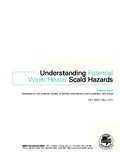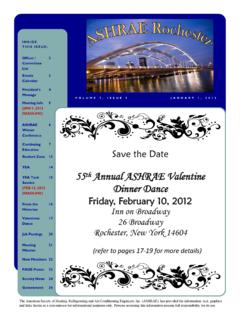Transcription of Handbook of Machining with Grinding Wheels
1 This document contains materials is copyrghted by CRC Press 2007 Handbook ofMachining withGrinding Wheelsloan D. MarinescuMike HitchinerEckart UhlmannW. Brian RoweIchiro InasakiAVAILABLE THROUGH THE ABRASIVES PRESS2006 ISBN 1-57444-671-1 This document contains materials is copyrghted by CRC Press 2007 PrefaceGrinding, once considered primarily a finishing operation involving low rates of removal, has evolved as a major competi-tor to cutting, as the term abrasive Machining suggests. This is what Milton Shaw, the man who is considered the greatpioneer and father of American Grinding , said about 10 years ago. Shaw led the development of Grinding in the UnitedStates over the last 50 named this book Handbook of Machining with Grinding Wheels because the borders between Grinding and otheroperations such as superfinishing, lapping, polishing, and flat honing are no longer distinct.
2 Machining with grindingwheels extends from high-removal rate processes into the domains of ultra-high accuracy and superfinishing. This bookaims to explore some of the new transition operations, and for this reason we chose this book presents a wide range of abrasive Machining technology in fundamental and application terms. Theemphasis is on why things happen as they do, rather than a how-to-do-it approach. The topics covered in this book covera range of abrasive Machining processes with Grinding Wheels , making this probably the most complete book regardingall kinds of Grinding aim of this book is to present a unified approach to Machining with Grinding Wheels that will be useful in solvingnew Grinding problems of the future.
3 It should be of value to engineers and technicians involved in solving problems inindustry and to those doing research on Machining with Grinding Wheels in universities and research team of authors are famous researchers who have devoted their entire lives doing research in this field and who arestill actively contributing to new research and development. The authors represent a large region of the world whereabrasive Machining with Grinding Wheels are most advanced: United States, Great Britain, Japan, and Germany. I thank myco-authors for taking time from their busy activities to write and review this book over a period of 2 main purpose of this book is to present abrasive- Machining processes as a science more than an art.
4 Research anddevelopment on abrasive- Machining processes have greatly increased the level of science compared to 25 years ago whenmany aspects of abrasive Machining processes still depended largely on the expertise of individual technicians, engi-neers, and book has two parts: The Basic Process of Grinding and Application of Grinding Processes. This structureallows us to present more about understanding of Grinding behavior in the first part and more about industrial applica-tion in the second part,loan D. Marinescu Toledo, 2006 This document contains materials is copyrghted by CRC Press 2007 The Authorsloan D.
5 Marinescu is a professor of mechanical, industrial, and manufacturing engineering at the University of Toledo. Heis also the director of the Precision Micro- Machining Center of the College of Engineering ( )of the same university. He has a in manufacturing processes, an honorary doctorate from University of lashi, Romania,and is a member of numerous international professional organizations: JSPE, SME, ASME, ASPE, CIRP, IDA, ASAT, Marinescu is author of more than 15 books and over 300 technical and scientific papers. He has given lecturesand workshops in more than 40 countries around the world. Also, he is the executive director and cofounder of the AmericanSociety for Abrasive years ago, Dr.
6 Marinescu founded his own company, Advanced Manufacturing Solutions Co., LLC, a company thatspecializes in consulting, R&D, manufacturing, and trade ( ). He is the president and CEO of this Hitchiner obtained his doctorate in 1982 at the University of Oxford for research in Grinding and Machining withcubic boron nitride (CBN) and diamonds. After a another 3 years of university research in diamonds and CBN, he joinedSaint-Gobain Abrasives (SGA) and its affiliate companies in 1985. He worked initially on conventional abrasive grainmanufacture and advanced ceramics before becoming R&D manager for vitrified CBN in Europe in 1987.
7 In 1989, hejoined Universal Superabrasives (SGA) as technology manager for vitrified CBN for the market. More recently, he hasbroadened his responsibilities as the technology manager for precision Grinding applications for North America, as well asprojects throughout Asia and Uhlmann is the director of the Fraunhofer-Institute for Production Systems and Design Technology IPK andprofessor of machine tools and manufacturing technology at the Institute for Machine Tools and Factory Management ofthe Technical University in Berlin, Germany. He received his doctorate in engineering on Creep Feed Grinding ofHigh-Strength Ceramic Materials.
8 Prior to his academic career, he served several years as vice-president and director ofresearch and development at Hermes Schleiftnittel GmbH & Co., Hamburg, Germany. In addition to being a consultant forvarious German and international companies, Dr. Uhlmann holds many professional memberships, including the BerlinWissenschaftskommission, the Verein Deutscher Ingenieure, and the International Institution for Production EngineeringResearch. He also holds an honorary doctorate from Kolej Universiti Teknikal Kebangsaan, Brian Rowe gained 6 years of experience with Austin Motor Company, Birmingham, England, and another 6 years withWickman Machine Tools, Coventry, England.
9 He studied at the University of Aston in Birmingham earning an honorsdegree in mechanical and production engineering in 1961. He earned a for research on the mechanics of centerlessgrinding at Manchester University in 1964 and became a doctor of science in 1976 for his wider research on tribology. Hebecame the head of mechanical engineering in 1973 at Liverpool Polytechnic (later to become Liverpool John MooresUniversity) and eventually became assistant rector responsible for corporate academic development, strategic planning,and for development of research. In 1992, he relinquished his administrative responsibilities in order to focus on director of the Advanced Manufacturing Technology Research Laboratory (AMTREL), he built up a significant team ofresearchers that worked closely with industry in the United Kingdom.
10 AMTREL has madeThis document contains materials is copyrghted by CRC Press 2007 TABLE OF CONTENTSPart IThe Basic Process of Grinding .. IChapter From Craft to Science .. Basic Uses of Grinding .. Accuracy Required .. High Removal Rate Required .. of Hard Materials .. Elements of the Grinding System .. The Basic Grinding Process .. Four Basic Grinding Operations .. The Importance of the Abrasive .. Grinding Wheels for a Purpose .. Problem-Solving .. Part I .. Part 11 .. 8 Chapter 2 Grinding Parameters .. wheel Life .. Redress Life .. Cycle Time .. Process Uncut Chip Thickness or Grain Penetration Depth.





